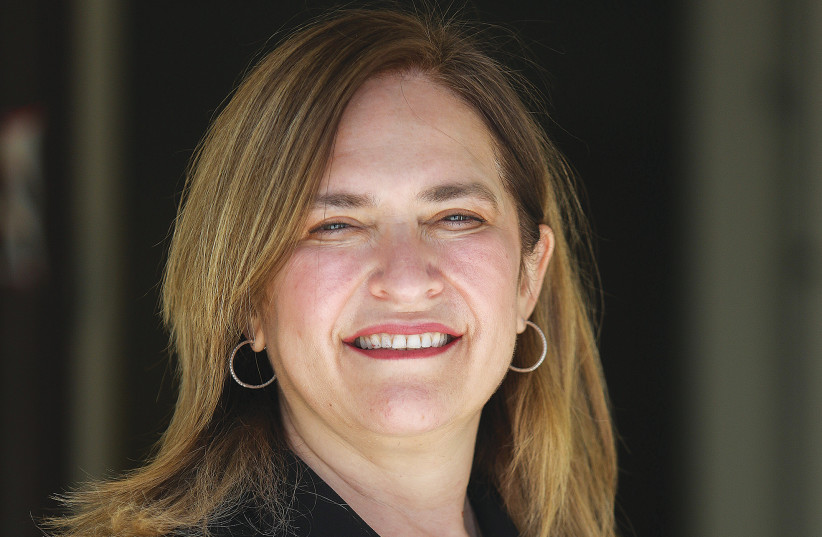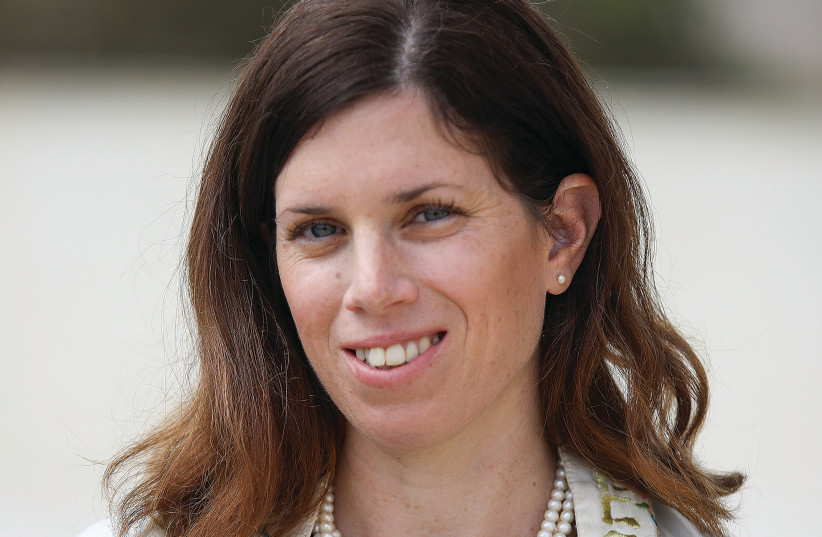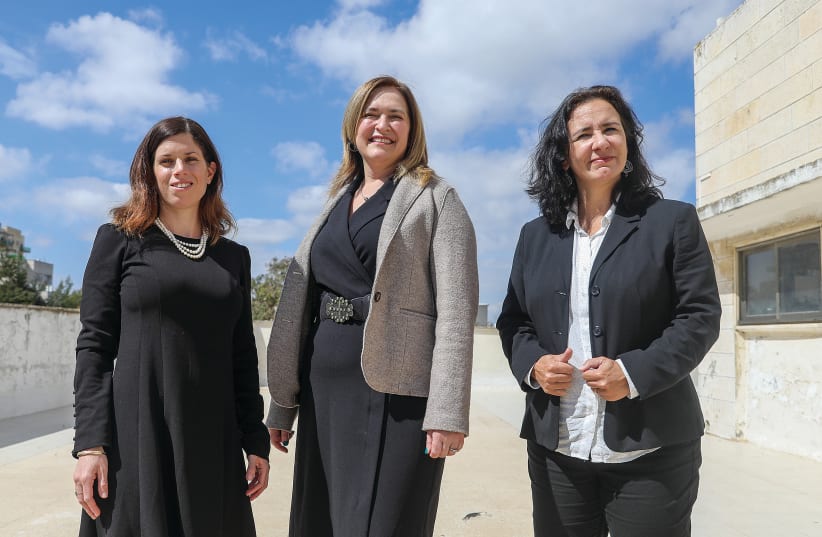Rakefet Ginsberg is the first woman to head the Masorti (Conservative) Movement in Israel. Yet even though she grew up in an entirely secular household, her father wasn’t thrilled when she told him she was chosen to lead the movement.
“My father grew up in the Vizhnitz ultra-Orthodox hassidic group,” She recently told The Jerusalem Post. “When I told my parents I was applying for this position, my dad immediately said it was ‘not a job for a woman.’ Now he knew that I worked for the Masorti Movement, but for him and for most Israelis, religion, Judaism and leadership are for men.
“The fact that there are women running these movements is historic. The problem is the state of mind that people have of leaders. For most Israelis, there can be women around the man who is a leader, but in the end, the man is the one who is considered the more senior leader. The fact that a woman is the senior leader of a religious stream is a revolution.”
When asked if her father’s attitude toward her leading a religious movement came from a conservative approach, or was maybe even chauvinistic, Ginsberg didn’t shy away.
“Listen, he actually already met a female rabbi. He knows what Masorti Judaism is about. He understands that it is possible. He just isn’t able to imagine how this role would be fulfilled by a woman – he can’t bring himself to imagine it. When people talk about religion and Judaism, we are used to seeing pictures of men leading a service or ceremony.”


But your father decided to leave Orthodox hassidic Judaism. Why would he care if his daughter ran a liberal stream of Judaism? I asked.
“My mother was mad at him. My children also said, ‘Grandpa!’ and he just went silent. It has nothing to do with logic but actually with emotion. My father quickly realized what he said and that it didn’t make any sense.”
I met Ginsberg at the offices of the Masorti Movement in Jerusalem’s Baka neighborhood together with two of her colleagues, women who head religious movements in Israel – Anna Kislanski, the CEO of the Reform movement in Israel, and Yochi Rappaport, the executive director of Women of the Wall.
Ginsberg lives in Rosh Ha’ayin and is a Sabra who grew up in a secular family. She’s the mother of three sons. When asked how she came from a completely secular background to the position of running a pluralistic religious movement, Ginsberg answered: “I was looking for Judaism that could accept my family and myself as one unit. I started looking for a synagogue for my eldest son’s bar mitzvah. And since we were on shlihut in the US for the Jewish Agency, I realized that there were a lot of options of Judaism and found a Masorti community. When we came back from shlihut, I was looking for a permanent community that suited me and my family.”
Ginsberg’s husband actually grew up in what she calls a “Conservadox” community in Argentina, and he therefore has a basis of knowledge and mentality that suited a Masorti synagogue.
“There isn’t a Masorti synagogue in Rosh Ha’ayin. Therefore, we are members of a community in the nearby city of Hod Hasharon.”
She’s been CEO of the Masorti Movement for more than a year, after seven years of managing the community development branch of the movement.
Kislanski grew up in a very secular background.


“My family immigrated to Israel in the 1970s from the former Soviet Union,” she told the group during our conversation. “My family’s way of expressing their Jewish identity was to immigrate to Israel, because there was Soviet rule at the time.”
Kislanski explained that “I asked myself a lot of questions about my identity. We didn’t want to get married in the rabbinate but, rather, have a Reform rabbi officiate our marriage, but we were sure that there were only Reform rabbis in America.”
Out of all the people in the world, it was the DJ they hired for the wedding, who recommended a then-young Reform rabbi in Tel Aviv named Meir Azari. “Later on, I started working as a community coordinator for the Reform movement in Haifa. I was also on shlihut for the Jewish Agency as the senior emissary of the Reform movement in North America.”
Kislanski lives in Even Yehuda, is married and has two daughters and a son.
She worked for nearly 12 years at the headquarters of the Reform movement in Israel, and was chosen to replace Rabbi Gilad Kariv as CEO when he was elected to the Knesset in the last elections.
Rappaport actually grew up in a classic religious-Zionist atmosphere in Safed. She was a member of the Bnei Akiva youth movement and studied in an ulpana, a high school for religious girls. The changing point in her life was when she served in the army.


“I was a commander in the Nativ course, which is in charge of conversion to Judaism for soldiers. I fell in love with the liberal and feminist Jewish world,” she said.
She worked for different organizations in the world of cultural Judaism and afterward for Women of the Wall for six years.
“In May 2019, I was appointed as director-general,” she said – the only one of the three women who wasn’t the first woman to work in this role. She is married, the mother of two daughters and a Jerusalemite. Rappaport’s family are members of an egalitarian open Orthodox community.
To what extent were these movements that you run controlled by men?
Ginsberg: “In the Masorti Movement it is a bit different. For many years the chairperson was a woman. There were many respectable positions that women in Israel gradually were promoted to. There was even a female chair of the Rabbinic Assembly in the US. As a movement, it surprised us that I was the first woman to take on the leadership role of director-general. Yet something in the internal culture of the movement has meant that despite the equality, it didn’t happen.
“I also think that there is a big difference between male management and female management. It’s not that women’s place is absent – it is absent in certain roles.”
Kislanski: “I agree with Rakefet that it was not intentional that no woman has been director-general of our movement till I was elected. There is an evolution taking place here.
“When you look at women in rabbinical positions in communities, we have already reached a point where we have a little over 50%. We have many women rabbis in the movement and in the communities themselves. Perhaps what I will say is not coincidental – we grew out of the silence. I managed the movement’s field activities as vice president in Israel. I feel like the change is happening from the bottom up and not the opposite. Both Rakefet and I worked in roles of professional and volunteer leadership. Nowadays, the chairwoman of the Rabbinical Council of Progressive Judaism is also a woman. We also are proud that the head of our conversion court is Raba Galia Sadan, a female rabbi.
Rappaport said that she hoped one day a female director-general will be chosen in the Bnei Akiva movement she grew up in.
“They are actually looking for a new director-general, and I truly hope that maybe for the first time a woman will be elected. I’m not getting my hopes up yet.”
Rappaport explained that she also has criticism towards secular Israelis. “When I talk about religion in Israel, the seculars suddenly jump up in surprise when they see a woman wearing a tallit [prayer shawl]. That’s part of the story we’re talking about. We are drawing a line and saying that religion belongs to everyone.”
She added that “this is part of the task of Women of Wall as a movement: to normalize religion and to make sure that the public understands that it also belongs to women.”
Rappaport said that she is asked frequently, “Why exactly do you have to make trouble at their Wall?” I answer them that the Kotel is public and does not belong to anyone. Precisely from the secularists I hear more shock about what we do at the Kotel. There are also those secular Israelis who don’t want any connection to religion, because for them it does not allow equality. The seculars in Israel are very conservative. They will say, ‘How dare you change something traditional?’ Yet there are the seculars in Tel Aviv whose attitude is: if Judaism is not equal towards LGBTs and women, then they don’t want to be part of it. Our goal is to promote Judaism that embraces all Jews, not the opposite.”
Kislanski: “Conservative Judaism has an ongoing dialogue with Orthodoxy since they are more similar to each other. The Reform movement has an ongoing dialogue with Israeli secularism. Secular Israelis range from those who the synagogue they go to once a year is Reform to those that will say outwardly: ‘Why do you need a synagogue at all?’ There is a significant shift among the secular public in Israel. I mostly see the positive side of it.
“But the ultra-Orthodox and extremist Orthodox also pay attention to this – the fact that we’re proud of our Reform Judaism and creating public dialogue. When this happens, there is also a lot of incitement and rage against the liberal movements. We are already used to the fact that there are occasionally stones thrown at our synagogues or flyers distributed claiming how terrible we are. There usually is a corny picture of a dog with a kippah with the ‘bark mitzvah’ wording – as if all Reform Jews celebrate bar mitzvahs for their dogs. The community in Shoham suffered a lot from these types of attacks.”
Ginsberg: “Once upon a time, only one type of synagogue was known in Israel. Once there is a choice for people to choose from, the monopoly disintegrates. We see it happening: more and more Israelis become members of our synagogues. Suddenly, secular Israelis understand that they do not have to give up everything they believe in, in order to go to synagogue. A secular mother understands for the first time that she doesn’t have to dress up with a dress and hat in order to participate in her son’s bar mitzvah. Now these women know that there are other options of Judaism that speak their language.
“The secular public is alienated from the growing Israeli Orthodoxy. And when they leave Orthodoxy, many of them find themselves by us. It’s not like we have to beg people on the street to join our communities or services; we were present, and people came. On Yom Kippur, our synagogues explode with people wanting a place to feel comfortable and a religious leader that can communicate with them in their own cultural language.”
The Pew survey that examined the religious streams in Israel in 2014 stated that there are only 5% of Israelis who recognize themselves as Reform or Conservative Jews in Israel. This still is a minor group in Israel.
Ginsberg: “You can’t run a survey and ask Reform and Conservative Israelis the exact same questions, without understanding the huge differences between these groups. The parameters of Orthodoxy are praying three times a day in a synagogue, yet that’s not the same for Conservative and Reform Jews. So if someone asks a Reform Jew if he goes to synagogue every day, this doesn’t mean he doesn’t identify with our approach to Judaism. This also doesn’t mean that he should not be given an egalitarian area to pray at the Kotel. Examining how many go to a Conservative synagogue is a nonrelevant criterion. Instead, the question should be: ‘If you were to go to a synagogue today, where would you go?’ Another thing is: they won’t even always know to say if the synagogue they go to is Reform or Conservative. From many of their perspectives, they just went to a synagogue in the neighborhood.
“Many people who come to our synagogues hold positions on Judaism that are more similar to those of the traditional and Reform Jews in Israel than of the Orthodox. Therefore, the polls aren’t always able to truly examine the phenomenon of Reform and Conservative Jews in Israel.”
Kislanski: “During the lockdowns of the COVID-19 pandemic, we had more and more people that aren’t members of our communities join in prayer services and events online. There are so many Israelis looking for religious experience.”
She said that there were tens of thousands of Israelis who participated in online activities during COVID-19.
Ginsberg added that during the High Holy Days, a Masorti community in the city of Rehovot had 5,600 people participate in its online services. “They had male and female cantors, and they didn’t do any publicity. Since we abide by the Halacha, we make sure to start streaming before the holiday begins, and therefore don’t desecrate Jewish law. Our Rabbinic Assembly published a ruling that allowed this type of broadcast, and it was also accepted by the rabbis in the United States. Since we are a democratic movement, the rabbis decided whether to broadcast prayers or not.”
Rappaport, the youngest of the three women interviewed, said she is constantly invited to speak to groups across Israel, whether liberal religious schools or secular educational institutions.
“I meet about 120 groups a year, and I speak to them about Women of the Wall or even just about Judaism in general. Sometimes I meet young girls who wrote an essay about our movement.
“Many teachers tell me that they want to bring Judaism to their students but not a Chabad rabbi, for example, because the students don’t relate to them.
I speak about liberal Judaism, and many of these students respond in a surprised manner: ‘Wow, we didn’t know that this type of Judaism exists.’ They want our Judaism.”
How do you see the combination of religion and female leadership in the next decade in Israel?
Kislanski: “Religion and female leadership are issues at the core of the Reform movement, and are intertwined with significant milestones in history:
“Exactly 40 years ago, in 1992, the first female Reform rabbi in Israel was ordained – Rabbi Naamah Kelman, who is currently the dean of the Hebrew Union College in Jerusalem and one of the most prominent leaders in our movement.
“Her ordination was announced 20 years after the ordination of Sally Priesand, the first woman to be ordained as a rabbi in the United States. Rabbi Naamah’s certification has broken the dam in the Reform movement for Israeli female leadership, and since then we see a growing variety of leadership in our communities.
“Beyond that, my leadership as the first woman director-general of the Reform movement in Israel fills me with pride that we have paved the way for women in spiritual leadership roles both in the liberal world of Jewish renewal in Israel and in the Orthodox religious world, where we find more and more women leaders. I see how, in 10 years from now, we’ll see more and more women leading liberal and even Orthodox communities in Israel. We see more and more girls insisting on having a significant bat mitzvah, and I am optimistic that this voice will intensify in Israeli society.”
Rappaport: “Looking at reality today, and how both men and women are pushing towards women in religious leadership positions, and the thirst there is to see more women taking part, and how much we add, I trust that in 10 years from now we will see the vision of the end of the days, where men and women, collectively, are able to serve as leaders and provide religious support and answers. People have a thirst towards female religious leadership, and if we all push together, the egalitarian section at the wall will open up and serve the nation proudly.
“I also see pushback from the radicals who refuse to see any form of change within religious life. Since our society cannot understand how a woman can serve as a Supreme Court judge but not as a rabbinic one, they will demand change.”
